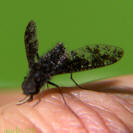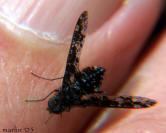| Bee Fly – Anthrax sp. Family Bombyliidae –Bee Flies Flies Main | Flies Index | Tachinidae | Syrphidae | Bee Flies | Blow Flies | Flesh Flies Live adult fly photographed at West Chicago Prairie, DuPage County IL June 16, 2005. Size: 6mm |
|

|
Bombyliidae is one of the largest families of Diptera, with over 5,000 valid species described worldwide. Their high diversity may be due to the parasitoid habit of the majority of their larvae. Adults feed on nectar and pollen, and are believed to be important pollinators of many plants, although few species have been studied in detail. Bee flies occur on all continents except Antarctica, however their highest diversities occur in semi-arid and arid environments (Hull, 1973).
The family includes a wide variety of morphological forms, such as the enormous Palirika marginicollis (Gray), with irridescent green-blue body scales recalling those found on the wings of a Morpho butterfly, and striking black and hyaline wings spanning 45 mm; and the tiny, delicate, humpbacked yellow and black species of Glabellula Bezzi with hyaline wings and a body length about 1 mm. |
 |
 |
 |
Flies of North America – Order Diptera. Flies are prevalent in virtually all habitats, with over 16,000 species in North America. Flies can be distinguished from all other insects in that they only have one pair of normal wings. The other pair has evolved into small ball-like structures called halteres. Most flies have compound eyes and mouthparts adapted for piercing, lapping or sucking fluids.
Syrphidae | Flies Index | Tachinidae | Bee Flies | Robber Flies |
